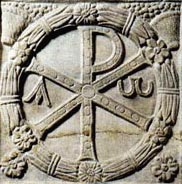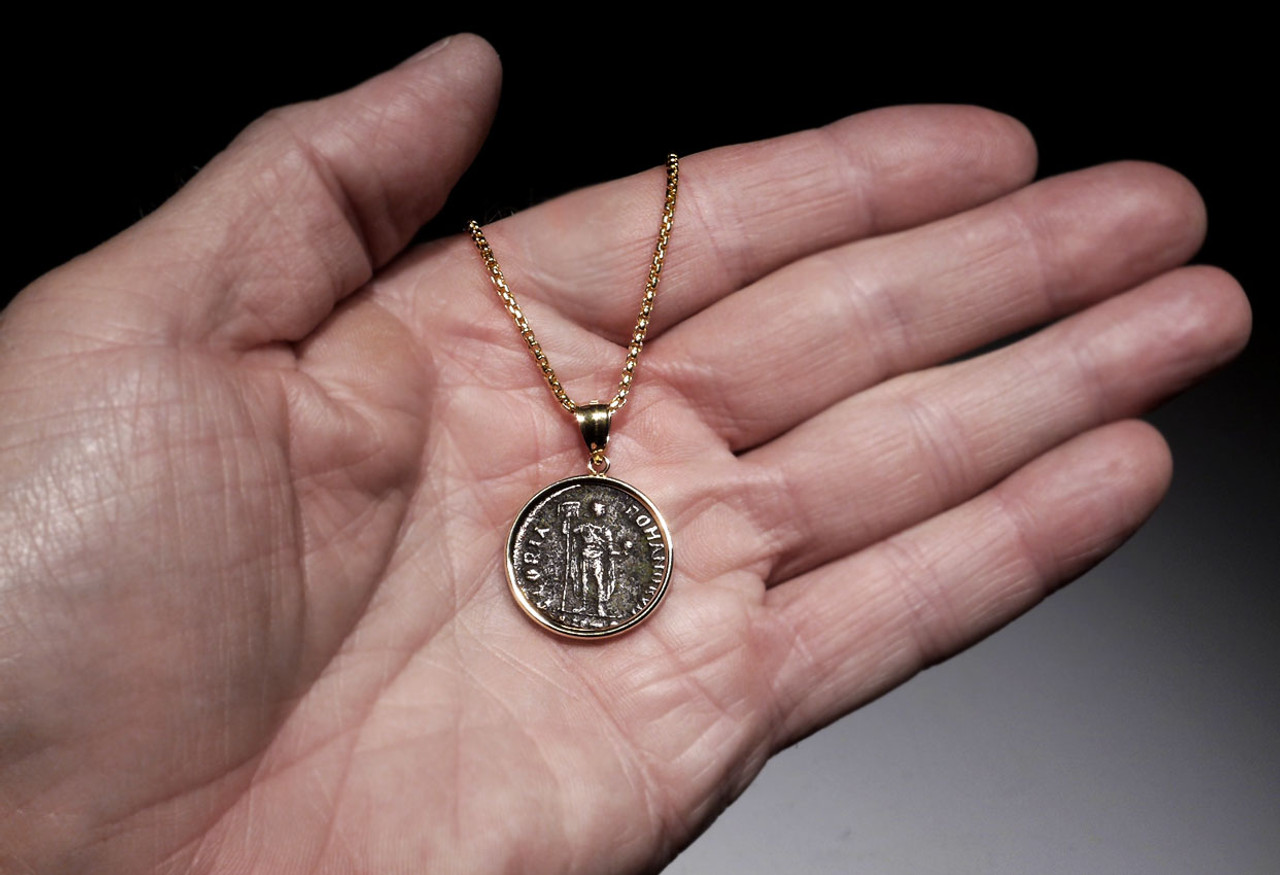Product Description
This impressive, genuine ancient Roman bronze coin was minted between 364 A.D. - 375 A.D. during the rule of Valentinan I, aka Valentinian the Great. It is set with the reverse side showing the Roman emperor holding a standard and globe with the inscription around the image "Gloria Romanorum" which translates to "The Glory of the Romans". It is set in a high polished 14K yellow gold smooth pendant setting in a unisex design making this pendant equally fitting for wear by either a man or woman.
The coin features superb detail and high relief with a colorful patina. With an inscription 'The Glory of the Romans', this would be a perfect gift for anyone of Italian descent! From a time when the Empire of Rome personified honor, pride and achievement.
ADD THE DISPLAYED MEDIUM ROUND BOX GOLD CHAIN
SEE MORE ANCIENT ROMAN COIN JEWELRY
HISTORY
Born in 321 AD as Flavius Valentinianus in the southern ancient Roman province of Pannonia (now Vinkovci in Croatia), Valentinian I, or Valentinan 'the Great', came from an Illyrian family. Along with his younger brother Valens, they were the sons of Gratianus Major, a prominent military commander who served under the rule of the emperors Constantine I and Constans I. Valentinan and Valens were raised on family estate where they were schooled in various subjects of the arts such as sculpting and painting.
Valentinan joined the army and served with his father in Africa. While serving under the rule of emperor Julian the Apostate (361 – 363 AD), Valentinan refused to renounce Christianity and was disgraced in rank. Despite this, Valentinian rose through the military to high rank under Julian and Jovian, and after their deaths was chosen Augustus. Nine days later he appointed his brother Valens as co-emperor in the East while Valentinian ruled the West. Both agreed to allow religious tolerance during their reign, while maintaining their faith in Christianity.
Valentinan enjoyed many achievements during his rule. He was the last emperor to conduct military campaigns across both, the Rhine and Danube rivers. He rebuilt and improved fortifications along the frontiers even unto the extent of building military outpost forts in enemy-controlled regions. Due to the successful nature of his reign and the rapid decline of the empire after his death, he is often considered the "last great western emperor". He founded the Valentinian Dynasty, with his sons Gratian and Valentinian II succeeding him in the western half of the empire.
 No event in the history of the Western world was probably more pivotal than that of the Christian conversion of the emperor Constantine. Constantine the Great, as he is famously known, was the first ruler of the Roman Empire to convert to Christianity. His conversion resulted from a miraculous event that took place on the battlefield. Constantine was encamped with his army at the Milvian Bridge, heavily outnumbered by the armies of his challenger Maxentius, across the river. The following historical account was recorded at that time by an ancient writer as follows:
No event in the history of the Western world was probably more pivotal than that of the Christian conversion of the emperor Constantine. Constantine the Great, as he is famously known, was the first ruler of the Roman Empire to convert to Christianity. His conversion resulted from a miraculous event that took place on the battlefield. Constantine was encamped with his army at the Milvian Bridge, heavily outnumbered by the armies of his challenger Maxentius, across the river. The following historical account was recorded at that time by an ancient writer as follows:
"Constantine was praying to his father's god, beseeching him to tell him who he was and imploring him to stretch out his right hand to help him in his present difficulties. While he was fervently praying, an incredible sign appeared to him from heaven. (It would be hard to believe his account if it had been told by anyone else. But the victorious emperor long afterwards declared it to the writer of this history -- when I was honored to meet and talk with him and he even confirmed his statement by an oath. Thus, who could doubt him, especially since time has established its truth?)
He said that about noon, when the day was already beginning to decline, he saw with his own eyes the trophy of a cross of light in the heavens, above the sun, and an inscription that said 'Conquer by This' attached to it. Seeing this, he and his army, which followed him on an expedition and witnessed the miracle, were struck with amazement.
"He said that he doubted within himself what importance the vision might hold. He continued to ponder its meaning through until he fell asleep. While sleeping, the Christ of God appeared to him with the same sign he had seen earlier in the heavens. God commanded him to make a likeness of that sign which he had seen in the heavens and to use it as a safeguard in all encounters with his enemies."
Immediately, Constantine placed the sign of Christ on his standards and had it painted on his shields. Constantine won the day with a decisive victory and Maxentius, thrown from the Milvian Bridge, was drowned when the weight of his armor caused him to sink into the mud and ooze at the bottom of the River Tiber. His body was recovered the day after the battle. From this point on, Christianity became the official religion of the Empire and the capitol was moved from Rome to Constantinople (modern day Istanbul, Turkey).
Upon the death of Constantine the Great in 337 A.D., the Empire was divided among his three sons. The eldest son, Constantine II, took most of the Western Europe, the second son, Constantius II, received the entire Eastern Empire and the youngest Constans, ruled Italy and North Africa under the regency of Constantine II.
 US Dollars
US Dollars
 AUD
AUD
 CAD
CAD
 POUNDS STERLING
POUNDS STERLING










